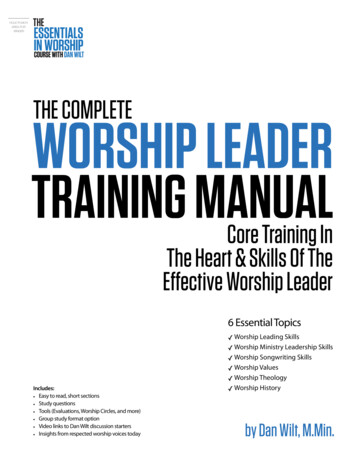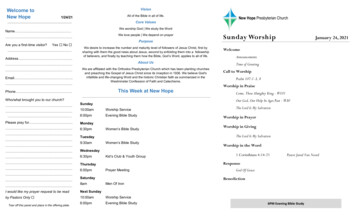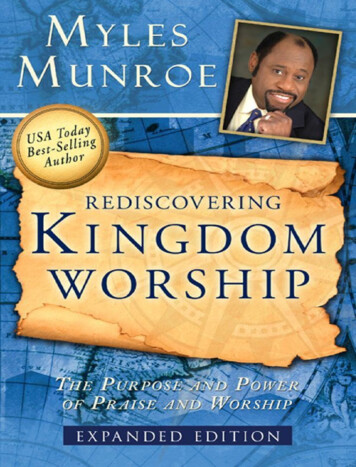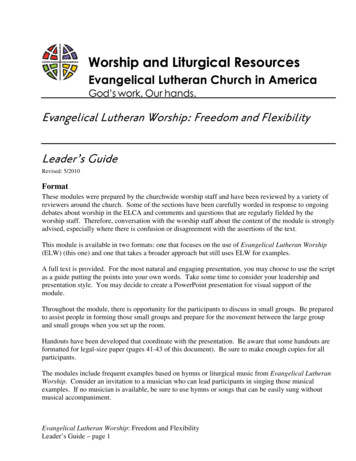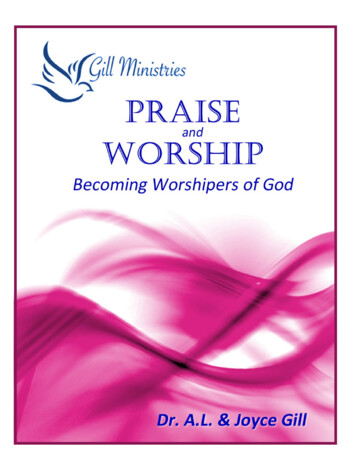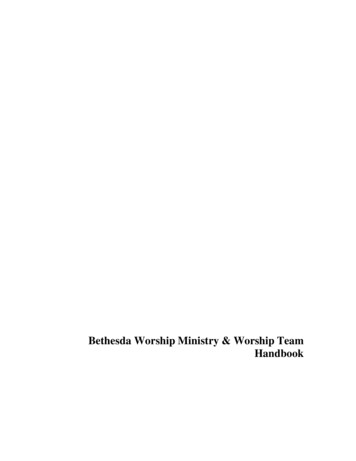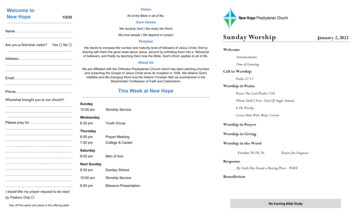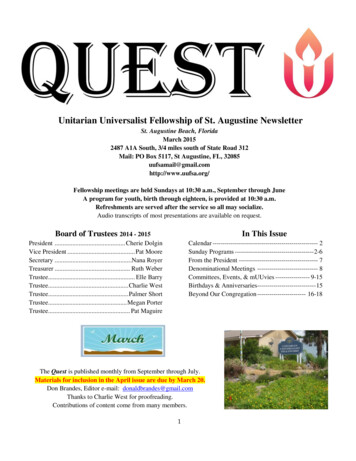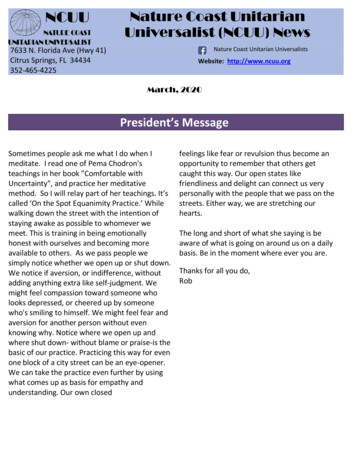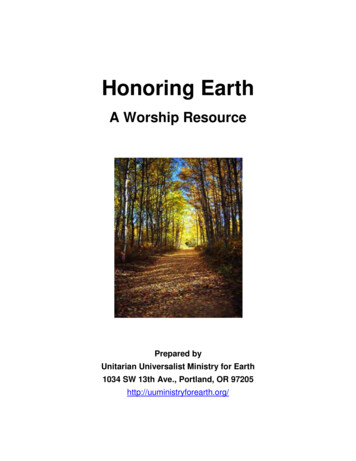
Transcription
Honoring EarthA Worship ResourcePrepared byUnitarian Universalist Ministry for Earth1034 SW 13th Ave., Portland, OR 97205http://uuministryforearth.org/
Copyright 2004, 2013 Unitarian Universalist Ministry for EarthFirst Edition June 2004;Reformatted for CD delivery, 2007Reformatted for Web delivery, 2013Unitarian Universalist Ministry for Earth1034 SW 13th AvenuePortland, OR tarian Universalist Ministry for Earth is an independent organization related to the UnitarianUniversalist Association.Our mission is to facilitate and support the work of Unitarian Universalists, by affirming and promoting theseven principles of the Unitarian Universalist Association, including the seventh: “to affirm and promoterespect for the interdependent web of all existence of which we are all a part.” We do this by focusing onthe theological, spiritual, and ethical aspects of human values and activities that affect the health andsustainability of living Earth.Our vision is that Unitarian Universalists recognize and embrace the moral imperative to live in covenantwith the web of life through personal, congregational, and denominational practices.As you use these materials, we hope that you will make an opportunity to educate yourself and othersabout the important mission and work of Unitarian Universalist Ministry for Earth. Please feel welcome tocontact us at office@uuministryforearth.org for information about our current programs.This resource is made possible by the generosity of individual donors and congregations. Please considermaking a donation today. Your gift will help UU Ministry for Earth develop additional resources. You maydonate online or send your contribution to Unitarian Universalist Ministry for Earth, 1034 SW 13th Ave.,Portland, OR 97205.Thank you for your commitment to Earth ministry. Working together, we will transform our individual andcongregational lives into acts of religious witness, discarding our harmful habits for new behaviors andpractices that will sustain life on Earth.This resource and additional materials are available on the UU Ministry for Earth website athttp://uuministryforearth.org/. You are welcome to adapt the materials in this Manual to make it as easyas possible for you to design a curriculum for your congregation. If you use or adapt the materials, pleasecredit the original authors when applicable and reference UU Ministry for Earth in any reprints oradaptations. We encourage you to print sparingly, using recycled paper and soy ink.NOTE: Some URLs in the 2007 edition are not accessible in 2013. The URLs that are notcurrently found are shaded in the text. Links to similar websites are provided.Honoring Earth2
Table of ContentsForward . 6Introduction . 7Words for Opening & Lighting the Chalice . 10Closing Words . 12Prayers and Meditations . 14Prayers . 14Manitongquat’s Prayer . 14A Closing Prayer to Follow Joys and Concerns . 15Prayers for All Living Creatures . 16Prayer of St. Basil . 16A Jewish Prayer of Praise for God’s Creation . 16Prayer of Commitment, U.N. Environmental Sabbath Program . 17Taken from Black Elk’s Prayer . 17An Ojibway Prayer . 18A Prayer of Thanksgiving & Blessing. 18Meditations . 19Drum, Dance, Chant and Song. 21Earth Jam . 21Music Resources . 21Circle of Song: Songs, Chants, and Dances for Ritual and Celebration . 22Chanting . 22Musical Accompaniment for Chants or to Use Alone . 22How To Work with Chants . 24The Power of Dance . 24The Sacred Circle Dance . 24Chain/Line/Snake Dance . 25The Sacred Spiral Dance . 25The Elm Dance . 25New Words to Traditional Songs . 27Sing Out for Creation . 27Been in the Storm So Long . 27Honoring Earth3
Noah’s Cargo . 29Wade in the Water . 28Readings . 30We Are Part of the Earth . 30The Four Elements . 31The Island Within . 31Water Dance . 32There Is Religion in Everything Around Us . 33Deeply Woven Roots . 33The Image of a Tree as Religious Icon . 34Let Us Plant Dates . 34From the Poetry of Gwen Frostic . 35Deep Ecology Platform . 36From “Tintern Abbey” . 36Isaiah 24:4-5 . 37The History of the Universe in 200 Words or Less . 37Among the Stars . 37How Lightly Might Earth Bear Man Forever . 38Wild Healing . 39Connecting Wildness to Wildness . 40We Are In This Together . 40Preamble to the Earth Charter. 42UUA General Assembly Ecological Resolutions, 1961-2012 . 43Sermons . 44Earth: Aspiring to a New Relationship . 44Earth or "the earth" - What's in a Name? . 48REPENT!!! Excerpts from a Message for Advent. 49The Environment and War. 52The Living Water . 55Tree of Life Sermon . 60Earth Spirituality is a Many Splendored Thing . 63The Comforting Whirlwind: God and the Environmental Crisis Sermon . 67Reverence for Life . 72The Body of God . 76Wake Now, My Senses: The Religious Imperative for Earth Stewardship . 79Honoring Earth4
Making the Earth Sacred Again . 82Two Homilies . 87Mother in Green . 90Thinking About Nature: Do Environmental Ethics Matter? . 93The Mud and Dirt of Things . 97Fire and Emptiness: Unitarian Universalism and the Universe Story. 101Worship Service Sampler . 111The Earth Our Mother . 111The Man Who Planted Trees. 118An Apple To Keep . 118The Earth Is Our Mother . 119Celebrations and Rituals . 124A Maypole Dance from Alaska . 124We Are Made of Stardust . 125The Stardust Ritual - Outline of Content for One Person Leading the Stardust Ritual . 125The Stardust Ritual - Outline of Content for Six Persons Leading the Stardust Ritual . 126The Universe Story as Unfolding of the Triple Goddess and Her Seasonal Celebration . 128Blessing of the Animals . 136Service Outline . 136Homily - Learning from Our Animal Companions . 137Alternative Participatory Animal Blessing . 138Small Inspirations: Quotations on the Environment and Environmental Justice 139Bibliography . 148Books . 148Periodicals . 153Honoring Earth5
ForwardWhat am I? Who am I? Where am I? Why am I here? These questions are at the heart of religious life.In our Unitarian Universalist tradition we acknowledge that there are many sources that can inform thepersonal quest for answers to these questions. In our worship services, we often turn to the teachings ofthe world’s religions and to philosophers and poets for our comfort, inspiration and understanding.Honoring Earth invites us to make integral to our worship the inspirations and the understandings we gainfrom acknowledging our deep connections with the natural world and with our living planet. The UnitarianUniversalist Seventh Principle “affirms and promotes the interdependent web of all existence of which weare a part.” Imagine what justice and healing for our world might come from more fully living according tothis principle. Imagine how our spiritual lives might respond to nurturing a deeper religious connectionwith the wondrous story of our place in the unfolding universe? Should we not seek on every occasion toexplore, renew, heal, and celebrate this awe-inspiring relationship? For inherent in the manifestations of“the interdependent web of existence of which we are a part” are nearly limitless opportunities to expressour love and concern for the Earth and all living creatures in every form of worship in which weparticipate.Honoring Earth is an attempt to blend our factual understanding of cosmology, astronomy, physics,chemistry, biology and botany with the contemplation, awe, and mystery that speak to our spiritualdimension. We hope that the voices of our elders and the gracious contributions of UU ministers,directors of religious education, Green Sanctuary committee members, lay leaders, and others whosewords appear on the following pages will inspire you to bring Earth-honoring elements of worship intoboth your personal lives and, naturally and often, into the worship experiences within your congregations.We of UU Ministry for Earth wish to thank all who have contributed to this first edition of Honoring Earthand invite you to participate as well. Additional contributions of material are most welcome and will beincluded in future editions and posted on our website: http://www.uuministryforearth.org. To submitmaterials for future editions, please send electronically, if possible, to office@uuministryforearth.org ormail to: UU Ministry for Earth, 1034 SW 13th Ave., Portland, OR 97205.Care has been taken to acknowledge and obtain permissions for all work that appears in these pages.We have followed Unitarian Universalist Association guidelines in determining “fair use” of quotedmaterials. With so many contributors, the process has been complicated, and if any requiredacknowledgements have been omitted, or any rights overlooked, it is unintentional, and we ask yourforgiveness. If notified, UU Ministry for Earth will be pleased to rectify any omission in future editions.You are welcome to use any portion of this resource for education or worship, but please respect andhonor the contributing authors by giving full credit to them. In addition, we ask that you acknowledge UUMinistry for Earth when using these materials. We hope that as you and your congregation or fellowshipenjoy and use this resource, you will support our work with your generous individual and congregationalmemberships. Only with you can UU Ministry for Earth continue to help Unitarian Universalists toembrace the moral imperative to live in covenant with Earth.Claudia Kern, EditorHonoring Earth6
IntroductionRev. Katherine JeschIn these challenging times, it is especially important to look to our spiritual lives for sustenance and hopeas we struggle with how to respond to all the crises we face, small or large, local or global. Many of uslook to our spiritual connection with nature and how that relationship nurtures and sustains us as we seekto heal a broken world. A healthy, Earth-based spiritual life is a way to be fully at home in our lives andon this earth. A strong spirit helps us to weather the storms of life.Worship as spiritual practice is a central part of our congregational life. Our weekly worship services arethe most common and consistent gathering place, offering both the space and time in our daily busy-nessto pause and consider those most profound religious questions that give meaning to our lives.Worship is one of the four program elements of the Green Sanctuary Program, as developed by UUMinistry for Earth. As we struggle to create more sustainable patterns for our personal andcongregational lives, our Sunday worship services are occasions for education and inspiration, motivationand support. They are opportunities to celebrate our collective will, and the progress we have made.And perhaps most of all, they offer moments for healing.We need one or more “Earth Day-style” Sundays each year when we consider the earth, but we alsoneed to make room in every service to honor our life support system. In any given week of the year, wecan honor a turn on the wheel of the seasons, or acknowledge a victory for an ecosystem or life supportelement, or affirm the need for action in response to a new threat. In all cases, we want to hold up to ourcommunities our desire to change—for the health of our children, for the beauty of the earth, for thepeace we seek—and to accomplish this change peacefully.There are many ways to bring an Earth consciousness into both regular worship and special celebrations.But first we must consider what worship is and why it is important in our congregational life. In 1983, theUUA Commission on Common Worship published “Leading Congregations in Worship: A Guide.” Thatguidance has now found its way onto the UUA website at Worship egations/index.shtml. In the Introduction, worship isdescribed as a deeply human activity. We are reminded that, “though it is often defined as reverencegiven to a divine being or power, worship need not have supernatural implications. The origin of the word"worship" is in the Old English weorthscippen, meaning to ascribe worth to something, to shape things ofworth. We worship, then, whenever we ascribe worth to some value, idea, object, person, experience,attitude, or activity—or whenever we give form or shape to that which we have already found to be ofworth.”“Worship is usually considered to be a formal and deliberate shaping, ordering, or recalling of thethings of worth which we experience individually at various moments in our lives . . . This shapingis done in the context of a community of persons who share common values, ideas, andattitudes . . . The shaping process which is worship must have a social and historical dimension ifit is to be complete.”Over the centuries, worship has taken on or been assigned a number of different purposes. Severaldistinct styles of worship have evolved to meet these purposes, any and all of which can be focusedexplicitly or implicitly on honoring Earth.Honoring Earth7
Sacramental or dramatic worship. In this style, the worshiper is called to be part of the sacredevent and to be transformed by it. Words and actions are believed to participate in the divinereality.Educational or interpretive worship. The main purpose here is to express a particular idea ormessage. The goal is to move people, and through them, society -- to help create community,justice, equality, and to widen personal horizons. The appeal is to the intellect and the will ratherthan the senses.Celebratory worship. Worship as celebration emphasizes the artistic. It attempts to reflect all oflife, taking note of the realities already present in the worshiping community. Its purpose,however, is not to create community, inspire social responsibility, or teach a lesson, but is simplyto reflect, to celebrate.Thematic worship. This is a type of worship in which a particular idea or set of ideas isemphasized or clarified and applied to daily life. A single idea or theme is developed throughreadings, music, collective acts and a major presentation such as a sermon, panel, or sharingceremony. This style may combine one or more of the first three styles.Liturgical worship. Worship in this style usually follows a pattern that attempts to touch certainhuman needs. The service is performed as a “drama,” a choreographed event with a blending ofresponses, litanies, and prayers, and often a sermon or presentation. The repeated elementsbecome for the worshipers a common body of devotional material made familiar through frequentuse.High-quality worship engages people. It meets their needs to give praise, affirm common values,acknowledge inadequacies, experience something of the transcendent, reach toward the future in hope,and go forth in strength. Besides challenging them intellectually or ethically, it gives worshipers anopportunity to show gratitude, acknowledge errors and shortcomings, experience healing andforgiveness, and feel connected with the church community.Of course, worship rarely is, and need not be exclusively any one of these styles. There are times whenwe want worship to be educational. There are times when we want it to be playful or artistic. And thereare times when we want it to be truly transforming, even sacramental. Common worship can meet any orall of these needs.Earth-honoring worship nourishes our spirit by strengthening our sense of connection – with each otherand with Earth. None of us is isolated; feeling disconnected is usually recognized as a pathology to behealed. Worship, in its best forms, can be a tool for this healing. We recall the sustenance and comfortwe received from camping overnight in the woods, or walking on a deserted beach, or resting at the edgeof a meadow. We remember the spicy scent of cedar trees, the salt smell of ocean air, the rich musk ofdamp soil. We play again in our minds the symphony of wolves howling at the moon, or waves crashingon the beach songbird warbling in sunshine. And we are renewed and healed; we are stronger for theexperience.Honoring Earth8
And when the subject of our worship is endangered, as Earth is so profoundly today, our worship can –and should – inspire us to action, to taking responsibility for the healing that must occur in the world weleave for our children’s children and all future generations.We offer this collection of worship materials as a resource for designing Earth Honoring Worshipexperiences that will do all of this – honor and celebrate the interconnected web of life, nourish andsustain our spirits, and inspire us to go forth to heal this broken world – as we gather together in ourcommunities of faith.—Rev. Katherine Jesch, former Director of Environmental Ministry, UU Ministry for EarthHonoring Earth9
Words for Opening & Lighting the ChaliceAs surely as we belong to this universewe belong together.We join here to transcend the isolated self,to reconnect,to know ourselves to be at home,here on the earth, under the starslinked with each other.Rev. Margaret KeipThis earthen chalice was born of clay and water,The flesh and blood of Gaia;Given form by the hand of the potter,set by the bonding fire of the kiln.As we touch the flame to her lips,joining fire and air,May her light remind usof earth, air, fire, and water,of plant and animal, human and mineral,that we and the Earth are one.Rev. Edwin LaneHail Mother, who art the earth,Hallowed be thy soil, rocks and florathat nourish and support all life.Blessed be thy wind that gives us breathand thy waters that quench, bathe, and refresh all living things.Holy Earth -as one - we praise your majesty, grace, and wonder.-UnknownWe light this chalice with hopes for a bright future.May our children their children, all childrenIntermingle their laughter throughout the world.May they be as the rainbowColor and hope for the coming dawn.Reena KondoHonoring Earth10
I Believe in NatureFlorence EmmonsWe light this chalice to honor the orderly processes of the Universe, which hold the planets intheir orbits and control the activities of microscopic cells.To honor the pervading, impartial forces of nature through which destruction is madeconstructive;To honor the ever-changing beauty of the natural world, which brings joy and inspirationto many people;We believe in the healing and restorative power of nature without which all living thingswould be in great jeopardy;We believe in the profound lessons which nature teaches; lessons of struggle andadaptability, tenacity and purpose, endurance and growth, patience, balance, and the inevitabilityof cause and effect;We believe in the hope and faith which nature gives to the observant through predictable,compensatory certainties: light after dark, warmth after cold, peaceful calm after lashing storm,and always the miracle of the sun, the rain and the seed.Florence Emmons was baptized at St. Paul's Universalist Church (now the UnitarianUniversalist Church in Meriden, Connecticut) in 1912. She wrote this affirmation for an adultreligious education class at the church in the 1970s. Since then, the text has been used in Sundayservices and set to music. This reading first appeared in UU World XVII: 2 (March/April 2003):18Honoring Earth11
Closing WordsCreator God, we are grateful for the beauty of the earth,for all flowering things,for the water that nourishes all this and all of us.Forgive us when we despoil your creation,and help us to be more fully awake to the gifts of this natural worldand to be more careful stewards of these gifts.May we walk upon the earth in thankfulness all the days of our lives.Amen.--Rev. Dr. Marilyn Sewell“The True Reason the Forest is Called Primeval”Needles of heaven seek pinpricks through clouds of green. filter into dusts of light layer between laden boughs suspend themselves in vibrant airEmerge, to dance with shadow on the carpet floor.You are a child of this;Step softly.--Rev. Margaret KeipIn the beginning, there was Love,and Love created and thus became Creator.We give our humblest gratitude to the Creatorfor giving us the gift of Life in Loveheld so delicately in each and every breath.In a worldwhere the flapping of a butterfly’s wings over Transylvaniamay conjure up a storm in Gaithersburg,no one can say our efforts will prove insignificant.Whatever the outcome,we are called to actby our history,by our tradition,by the times in which we find ourselvesto protect this gift of life that connects us all.May we re
need to make room in every service to honor our life support system. In any given week of the year, we can honor a turn on the wheel of the seasons, or acknowledge a victory for an ecosystem or life support element, or affirm the need for action in response to a new threat. In all cases, we want to hold up to our
